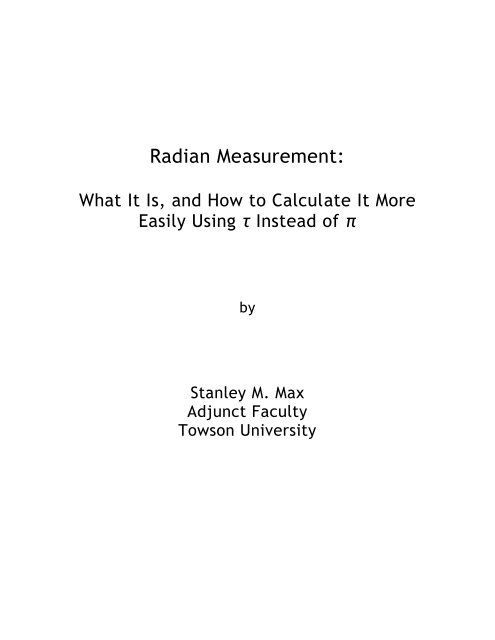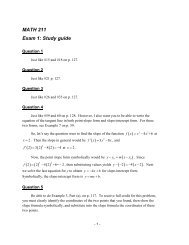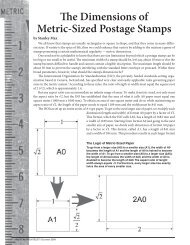Radian Measurement: - Metric Philatelist
Radian Measurement: - Metric Philatelist
Radian Measurement: - Metric Philatelist
You also want an ePaper? Increase the reach of your titles
YUMPU automatically turns print PDFs into web optimized ePapers that Google loves.
<strong>Radian</strong> <strong>Measurement</strong>:<br />
What It Is, and How to Calculate It More<br />
Easily Using τ Instead of π<br />
by<br />
Stanley M. Max<br />
Adjunct Faculty<br />
Towson University
<strong>Radian</strong> measurement<br />
In trigonometry, pre-calculus, and higher mathematics, angles are usually measured not in<br />
degrees but in radians. Why To some extent the answer to that question requires studying firstsemester<br />
calculus. Even at the level of trigonometry and pre-calculus, however, we can partially<br />
answer the question. Using radians offers a more efficient system for measuring angles<br />
involving more than one rotation. Quick, how many degrees does an angle have that spins<br />
around eight-and-a-half times By using radians, we shall see how speedily you can find the<br />
answer.<br />
So then, what is a radian Mathematically, a radian is defined by the following formula:<br />
s<br />
rad , where the symbol means “is defined as” (1.01)<br />
r<br />
In this formula, represents the angle being measured, s represents arc length, r represents<br />
radius, and rad means radians. Look at the following diagram:<br />
Figure 1: Arc length (s) = radius (r) when θ = 1 rad. Graphic created using Mathematica, v. 8.<br />
This picture shows that the angle is measured as the ratio of the arc length (s) to the<br />
radius (r) of an imaginary circle, and if the angular measurement is made in that fashion, then the<br />
measurement is made in radians. Now suppose that s equals r. In that case, equals one radian.<br />
In other words, one radian is the measurement of an angle that is opened just wide enough for the<br />
following to happen: If the angle is located at the center of a circle, then the length of the arc<br />
that the angle intercepts on the circumference will exactly equal the length of the radius of the<br />
circle. Shortly we will see that, converted to degrees, one radian equals just slightly less than<br />
57.3.<br />
- 1 -<br />
Copyright © 2011, 2012 Stanley Max
This raises an interesting question. How many radians can the central angle be Let’s say<br />
that the is opened up so that the arc length s is twice the radius length. Or three times, or four.<br />
How many radians would it take to go around the entire circumference of the circle — no more,<br />
no less<br />
Here is how we answer that last question. If the arc length s goes completely around the<br />
circle, then s becomes the circumference C. That is,<br />
But C is defined in terms of , as such:<br />
s<br />
C<br />
(1.02)<br />
C<br />
(1.03)<br />
d<br />
This last equation means that is defined to be the ratio of the circumference of a circle to its<br />
diameter.<br />
Of course, d 2r, so we can rewrite Eq. (1.03) in the following way:<br />
which in turn can be solved for C, as such:<br />
s<br />
So now we can rewrite rad to read as follows:<br />
r<br />
C<br />
, (1.04)<br />
2r<br />
C 2<br />
r<br />
(1.05)<br />
2<br />
r<br />
360 rad<br />
(1.06)<br />
r<br />
360 2 rad<br />
(1.07)<br />
180 rad<br />
(1.08)<br />
How to convert radians into degrees, and vice versa<br />
Eq. (1.08) is very important, because we use it to convert radian measurement to degree<br />
measurement, and vice versa. To go from radians to degrees, we divide both sides of Eq. (1.08)<br />
by to obtain the following:<br />
- 2 -<br />
Copyright © 2011, 2012 Stanley Max
1 rad<br />
180<br />
(1.09)<br />
<br />
And to convert from degrees to radians, we divide both sides of Eq. (1.08) by 180 to obtain the<br />
following:<br />
<br />
1 rad<br />
(1.10)<br />
180<br />
Incidentally, pay attention to this convention. If we are measuring angles in degrees, then<br />
we must use the degree symbol after the number. If we are measuring angles in radians,<br />
however, then we may write rad after the number or we may leave it out. Thus, for example, we<br />
<br />
<br />
may say that 30 rad or we may just say that 30 .<br />
6<br />
6<br />
Using Eq. (1.09) and Eq. (1.10), we can generate circles showing special angles, and we<br />
can measure these angles using either degrees, like here:<br />
Figure 2: Some special angles, in degrees. Courtesy Michael Hartl, The Tau Manifesto (2011). In<br />
http://tauday.com.<br />
Or we can measure the special angles using radian measurement, like this:<br />
- 3 -<br />
Copyright © 2011, 2012 Stanley Max
Figure 3: Some special angles, in π-radians. Courtesy Michael Hartl, The Tau Manifesto (2011). In<br />
http://tauday.com.<br />
A new way of measuring radians: Using τ instead of π<br />
Within the last year or so, a revolutionary new method of thinking about radians has come<br />
to the fore. According to this viewpoint, the fundamental circle constant should not be<br />
considered in terms of diameter, but rather in terms of radius.<br />
Recall Eq. (1.3) from above:<br />
C<br />
(1.03)<br />
d<br />
Instead of this definition, let’s use the following one instead:<br />
C<br />
(1.11)<br />
r<br />
Here, small Greek letter tau is defined to equal the circumference divided by the radius, and not<br />
the circumference divided by the diameter. In addition to thinking of Greek letter tau as , you<br />
can also think of it as a turn, meaning a complete rotation of the circle.<br />
Let us restate the equations by which we developed radian measurement in terms of ,<br />
and place those equations side by side with formulas to develop radian measurement in terms of<br />
.<br />
- 4 -<br />
Copyright © 2011, 2012 Stanley Max
C<br />
(1.04)<br />
2r<br />
C<br />
(1.11)<br />
r<br />
C 2<br />
r (1.05) C r<br />
(1.12)<br />
s<br />
rad<br />
r<br />
(1.01) s<br />
<br />
r<br />
rad (1.01)<br />
2<br />
r<br />
r<br />
360 rad (1.06) 360 rad (1.13)<br />
r<br />
r<br />
360 2 rad (1.07)<br />
180 rad (1.08)<br />
180<br />
1 rad (1.09)<br />
<br />
360 rad (1.14)<br />
360<br />
1 rad (1.15)<br />
<br />
<br />
<br />
1 rad (1.10) 1 rad (1.16)<br />
180<br />
360<br />
Thus, using — and thinking about it as a turn, a complete rotation — makes radian<br />
measurement more intuitive and therefore easier. One degree is one 360 th of a rotation — which<br />
makes sense — instead of 180 th of — which has no intuitive appeal. Furthermore, using<br />
Eq. (1.15), we can generate a circle showing special angles measured -radians.<br />
- 5 -<br />
Copyright © 2011, 2012 Stanley Max
Figure 4: Some special angles, in τ-radians. Courtesy Michael Hartl, The Tau Manifesto (2011). In<br />
http://tauday.com.<br />
Using this method, all radian measurements make common sense. For example, one<br />
<br />
quarter of a turn 90 equals radians — instead of radians — and one-eighth of a rotation<br />
4 2<br />
<br />
<br />
45 equals 8<br />
radians — instead of 4<br />
radians — and so forth. It could not be simpler and<br />
more direct. In fact, we can see that fractions of a circle amount to exactly the same thing as<br />
-radians.<br />
- 6 -<br />
Copyright © 2011, 2012 Stanley Max
Figure 5: Fractions of a circle are equivalent to τ-radians. Courtesy Michael Hartl, The Tau Manifesto<br />
(2011). In http://tauday.com.<br />
How to put this new method into practice<br />
Of course, the conventional method continues to use -radians, and not -radians.<br />
Unquestionably, I believe, the force of history causes the problem. For perhaps thousands of<br />
years, , which is defined in terms of diameter, has been used as the fundamental circle<br />
constant. And the definition that 180 rad has been used since 1873. If we could just start<br />
from scratch, then the logic of using , which is defined in terms of radius, would surely be used<br />
as the fundamental circle constant instead of the diameter-defined . In that case, textbooks<br />
would be writing that 360 rad , and that would make things a whole lot simpler.<br />
All of this may be well and good. But the influence of history persists, so what should<br />
students do when confronting the inefficiency of -radians Answer: Either disregard<br />
everything that I have just written in this paper and keep using the formulation that 180 rad .<br />
Or, better yet, continue to use the conventional definition of radians in terms of — since that<br />
is what all the textbooks do — but when you start getting confused and want to simplify things,<br />
just divide by 2. Once you have divided by 2, -radians becomes -radians. So, for example,<br />
<br />
180 rad = rad — one-half of a turn. The conversion is that simple.<br />
2<br />
- 7 -<br />
Copyright © 2011, 2012 Stanley Max
Using radians to measure angles involving more than one rotation<br />
At the very beginning of this essay, we claimed that using radians made it easier to<br />
measure angles that involved more than one rotation. We used the example of an angle that<br />
spins around eight-and-a-half times. Using degrees, the answer involves a clumsy multiplication<br />
of 8½ times 360 — 3060 . Using , the answer is 17 -radians — much simpler. But<br />
simplest of all is using — an angle that spins around eight-and-a-half times equals 8½<br />
-radians.<br />
Bibliographical essay<br />
In the fall of 2011, I came upon a short article entitled “π Is Wrong!,” by Bob Palais of the<br />
University of Utah. Prior to reading this article, I was not aware that a controversy even existed<br />
regarding whether or not should be used as the fundamental circle constant, and thus whether<br />
or not it should be used to measure radians. I next discovered Michael Hartl’s “Tau Manifesto,”<br />
posted in his website http://tauday.com. Hartl’s paper (from which I have used several graphics<br />
in this writing) is rather longer than Palais’, although Hartl himself acknowledged Palais as a<br />
trailblazer in advancing . Hartl’s article also provides a useful bibliographical essay. The<br />
website Spiked Math has opened up an enlightening forum on the debate. Furthermore,<br />
Wikipedia’s entry provides a valuable background to the discussion, including a reference to<br />
Joseph Lindenberg. The latter seems to have first come up with the idea in 1988 of using <br />
rather than as the fundamental circle constant, if I am correctly reading his instructive post in<br />
“Tau Before It Was Cool.” Lindenberg also contributed to the forum in Spiked Math.<br />
I learned from Russ Rowlett’s always useful “How Many A Dictionary of Units of<br />
<strong>Measurement</strong>” that James Thomson (brother of William Thomson, Lord Kelvin) named and<br />
defined the radian in 1873.<br />
Incidentally, from reading contributors’ comments in Wikipedia, Lindenberg seems to<br />
question whether the term “circle constant” has ever been used in any context outside of the -<br />
versus- controversy. Apparently, however, he does not object to the term, and he adopts it in<br />
his own discussion. I find the term handy, and more to the point I myself have become a staunch<br />
“Tauist.”<br />
Copyright<br />
This work is licensed under a Creative Commons Attribution-NonCommercial-NoDerivs<br />
3.0 Unported License. Thus, you may copy and distribute this work, provided that you attribute<br />
it to me (Stanley Max) and link back to http://www.stanleymax.net. Furthermore, you may not<br />
alter it or use it for commercial purposes.<br />
- 8 -<br />
Copyright © 2011, 2012 Stanley Max





